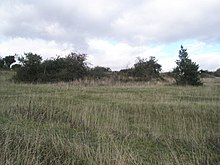| Site of Special Scientific Interest | |
 | |
| Location | Hampshire |
|---|---|
| Grid reference | SU 640 065 [1] |
| Interest | Biological |
| Area | 69.1 hectares (171 acres) [1] |
| Notification | 1984 [1] |
| Location map | Magic Map |
Portsdown is a 69.1-hectare (171-acre) biological Site of Special Scientific Interest on Portsdown Hill, on the northern outskirts of Portsmouth in Hampshire. [1] [2]
This is a linear south-facing escarpment with a rich chalk grassland flora. The diverse insect fauna includes all the chalk downland butterflies and a population of the largest British bush cricket, Tettigonia viridissima . On the lower slopes, raised beaches indicate former sea levels. [3]